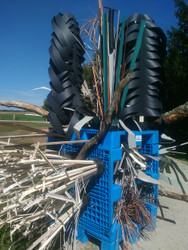The Science Behind Fishiding Artificial Fish Habitat (Part 8 of 10)
Posted by David Ewald and Eric Engbretson on 2nd Jan 2019
Part Eight: A Revolutionary New Design
In recent years, many new types of artificial fish habitat and various fish attractor styles have been installed from coast to coast. State agency fish managers and the fisheries industry as a whole, are using them to strategically enhance cover where natural habitat is at a premium. Although becoming very popular, numerous installers have reported some unanticipated problems. Because many current designs are fairly lightweight, they can be easily movable if not heavily weighted with additional materials. Once deployed, some models are prone to tipping over, sliding or being pushed around by wind, current and weather events. Boaters can inadvertently catch them on anchor lines, dragging them far from designated locations. Fisherman with strong braided lines can haul them up with this heavy gear. We’ve even heard reports of fisherman who find the attractors and move them to their own secret “honey holes”. Carefully marked GPS coordinates of where the structures were placed and should still be may be becoming less and less reliable, as installed materials get dragged away from the initial installation site.
Fishiding Habitat has been addressing these concerns throughout their product line, including the introduction of the new patent pending line of products called Fish Habitat Mats. Simply put, they’re immovable, modular, habitat platforms that an array of habitat components can be secured upon/inside in limitless configurations. They can be carried, rolled or slid around quite easily during assembly, but become virtually immobile once on the lake floor. Hundreds of pounds of safe, dense cover can be secured in one secure cluster. The Mats will create extremely large complexes of cover, breaking a size barrier that has been previously limiting. Now, the dimensions and proportions of the habitat complexes can be measured in yards not feet. They can be as large as you want them, creating the kind of genuine fish-holding habitat that up until now has been unimaginable. We finally have a way to create credible artificial rivals to large pieces of coarse woody habitat, sunken timber, dense beds of vegetation and other kinds of habitat that nature ordinarily provides.
Today’s video takes us to the Point View Resort on Missouri’s sprawling Lake of the Ozarks. Fishiding.com recently placed twenty separate Fish Habitat Mats, all outfitted with a variety of their habitat models and various PVC components. The Habitat Mats are designed to provide cover and protection for fish, along with improved angling opportunities for the resort’s fishing guests. The massive complex comprised of dozens of different models of artificial habitat, is believed to be the largest and most sophisticated of its kind ever used in a single location. We have known for years that to create a real fish magnet that’s stable, permanent and holds vast numbers of fish, it needs to be heavy and it needs to be big. The new Habitat Mat system recently placed in Lake of the Ozarks is colossal in scope. It’s a sophisticated fish-friendly habitat framework that was designed to grow aquatic life and make a real footprint on the lake floor, attracting and protecting substantial numbers of fish.
The largest pieces tower from the lake floor some 16 feet creating underwater skyscrapers for fish to use as refuge. In total, the assembled complex weighs over 7,000 pounds and creates over 8,500 square feet of surface area. Other resorts, including the Point View as well as individual homeowners on Lake of the Ozarks, have for decades placed cedar trees or brush piles into the lake attempting to attract fish. Recent flooding and storms washed away virtually all the existing fish habitat that was previously placed at the Point View Resort. The Fishiding Reclaimed Artificial Fish Habitat, incorporated and anchored to the newly installed Fish Habitat Mats, have the kind of permanence and stability that fish managers have been asking for.
Designing and building effective fish habitat is a genuine science. It’s still in its infancy, but we’re learning a great deal every day about the nuances of design and deployment. With today’s deep interest in artificial fish habitat, we’re eager to share our findings with fisheries professionals who want to learn more.
If you’ve missed any part of this series you can catch up at https://www.youtube.com/watch?v=6Krzy... For more information contact David Ewald at https://www.fishiding.com Phone: (815) 693-0894 Email: sales@fishiding.com



